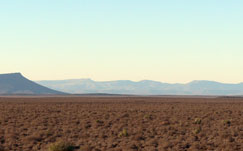Karoo rocks explain mass extinction
9 July 2015
Rocks and volcanic ash from the Karoo have led scientists from the University of
the Witwatersrand to deduce that a single global mass extinction event 260 million
years ago wiped out almost all life on the planet.
"The Chinese picked up a major turnover in rocks which pointed to a marine
extinction event of invertebrates round about 260 million years ago. We had a
feeling that our rocks [in the Karoo] would cover the same time period," said
Professor Bruce Rubidge, the interim director of Wits' Evolutionary Studies Institute.
It was initially thought by scientists that a land extinction event, which resulted in
the extinction of nearly 80% of species, happened earlier in a specific geological
period called the Permian, while the marine extinction happened at the end of that
period.
The team found that the traces of a mass extinction on land, and the date of the
rocks in the Karoo, matched the marine extinction that
the Chinese discovered.
A single cataclysmic event
Michael Day, a postdoctoral fellow at Wits who was continuing the work started by
Rubidge 30 years ago, said this new discovery suggested that there was one
cataclysmic event that led to both extinctions.
"A mid-Permian extinction event on land has been known for some time but was
suspected to have occurred earlier than those in the marine realm," he said. "The
new date suggests that one event may have affected marine and terrestrial
environments at the same time, which could mean its impact was greater than we
thought."
The end-Permian extinction is regarded as being more severe that the extinction of
the dinosaurs, which happened at the end of the Creataceous period 65 million
years ago.
The Permian extinction, which
National Geographic described as "when
life nearly came to an end", led to the disappearance of a diverse group of early
mammal-like reptiles
called dinocephalians, which were the largest land-living
animals of the time.
Riches of the Karoo basin
"The South African Karoo rocks host the richest record of middle Permian land-
living vertebrate animals. This dataset, the culmination of 30 years of fossil
collecting and diligent stratigraphic recording of the information, for the first time
provides robust fossil and radioisotopic data to support the occurrence of this
extinction event on land," said Day.
Rubidge said the mass extinction event also coincided with the time of catastrophic
volcanic activity in China. This was the prevalent theory on how the mass extinction
happened.
"The volcanic activity might have caused both extinctions [land and marine] as one
global event."
He said the Massachusetts Institute of Technology and the Smithsonian Institution
from the United States were part of the project.
The team's findings are contained in a paper titled:
"When and how did the
terrestrial mid-Permian mass extinction occur? Evidence from the tetrapod record
of the Karoo Basin, South Africa". It was published on 8 July in the latest issue of
the Royal Society's biological journal.
Source: News24Wire
 The semi-desert Karoo holds some of Earth's richest records of ancient fossils. (Image: MediaClubSouthAfrica.com, Andrew Luke)
The semi-desert Karoo holds some of Earth's richest records of ancient fossils. (Image: MediaClubSouthAfrica.com, Andrew Luke)




